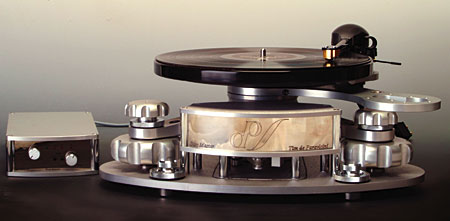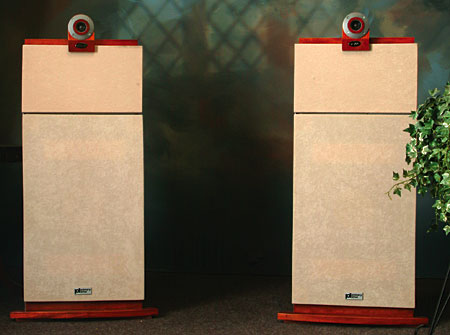| Columns Retired Columns & Blogs |
Tim de Paravicini: King of Tubes Page 3
"People will eventually believe McDonald's tastes good, if you force them. But there are people who like good food, and go out of their way to look for good food. The same with good music. And music is human emotion, it is every bit as important to us as food, because music conveys everything from laughter to crying to smiling to tears of joy.
"We've got to get people to realize—hold your horses, before it all disappears. In the pop field now, young bands are realizing that if they put the vinyl out, they know that the kids can't copy it. And the kids can now say to their peer group, 'I've got the Rotten Tomatoes record (or whatever the name of the band is), you haven't got it yet.' There's pride of ownership. But if you've got an iPod with 1000 tunes on it, you haven't got anything tangible to show what you own. It's a bit bucket, basically. And that's why, I think, vinyl has survived and has been growing. Because you've got a package, the record and the sleeve, that has some meaning."
Tim thinks that people will be playing vinyl records for the next 30 years or so. So perhaps it should have been no surprise when he decided to launch his own turntable, the EAR MasterDisk.

"The turntable is so complicated to discuss, it would probably take a couple of hours to describe it—it's not something that could be grasped in a few minutes. But the principle, what I was after, was a turntable that didn't sound like a turntable. I wanted you to hear the record, warts and all, but I didn't want you to hear extraneous problems that were going on in the room. That's why I developed the magnetic drive-coupling system, so I could divorce all the outboard world from the platter and tonearm. That was the secret of the thing, to make sure that the platter and tonearm are one entity that is isolated from the room and from all the boundaries, from noise and so on."
More recently, Tim finally decided to launch a CD player as well.

"I could have put out a CD player a long time ago, but I didn't. I held back, looking at it carefully, because I don't want to put out a product that has my name on it and have it coming back to haunt me. There's nothing to stop me doing new technology, I'll use transistors. If somebody wanted me to do class-D switching amplifiers, and I thought they were good, I would do them. If I thought they were good.
"Lots of people have made so-called valve CD players with a couple of token tubes. Most of them don't actually address the problem correctly, because a lot of them, if they're going to offer balanced outputs, actually go back into op-amps to do the balanced output configuration. So they've got this token tube doing not very much.
"I looked at CD players and I decided to use the Wolfson chipset, because I considered that to be the most analog-sounding (for want of a better word) D/A converter in the business. What I had to do, instead of using any further op-amp technology, was to get the output of [the DAC] and amplify it in the valve domain, and use an output transformer with a line stage similar to what I use in my professional audio equipment, to have the ability to drive both professional audio lines and consumer domestic audio. And if people want a minimalist setup, with an analog volume control on the CD player (and an output up to 5V instead of the usual 2V), it can drive any power amplifier.
"That's it! That's the logic of it. It doesn't have to be mega-expensive to make a statement. I want to sell a realistic number of them. It allows me [to compete], in the next year, when we can see what is the commercial reality of multichannel sound—whether Blu-ray or HD DVD win that race.
"A lot of audiophiles would like 2.1 [channels] rather than 5.1, 6.1, or 7.1. In other words, they've got their home theater, but they can't be bothered with the side speakers and all that, because they know it's all gimmicks. And if you reprocess the multichannels back to two channels and have a subwoofer driven from the 0.1 channel, you can get all your explosions and things to happen with your pictures. So I think 2.1 is a very good logical conclusion to it all. Instead of 5.1 upwards, go backwards!"
With the launch of his own Primary Drive loudspeaker, Tim de Paravicini can now offer a complete hi-fi system.

"I wanted a speaker that had some of the qualities of the Quad electrostatic, a dipole package that was not too big and awkward and had a degree of appeal to the domestic side of the family. I don't claim it to be the best-sounding speaker, though I consider it better than most packages on the market. But it had to be affordable and usable in the home, in a realistic situation.
"Basically, it's a dynamic speaker system, with a tweeter and a midrange and a bass unit. The bass unit and the midrange drive a membrane. The bass unit makes a membrane of effectively 12" by 18" (305mm by 457mm) surface area bend and vibrate to put bass into the room. So it has dipole properties. I don't make the drive-units myself and I subcontract the cabinets, but it's still my basic principles."
Tim has often been regarded as an eccentric genius, an audio maverick—always outspoken, sometimes outrageous. At one hi-fi show at least, when asked by another exhibitor to turn the volume down, he turned it up. He's been known to throw visitors out of his demonstration room when they've asked particularly stupid questions.
If Tim has mellowed in recent years, it might be because he's now getting more of the rewards and recognition his work deserves. Although his aristocratic ancestry can be traced back to 15th-century Italy, for him the important thing is what you do and how well you do it.
"Think about a thing carefully, and try and do it correctly," he says. "Don't think 'How can I save, cheapen it, cut corners, to bodge something to sell.' If you think with a salesman's hat on, you will never make a good product."
- Log in or register to post comments




































